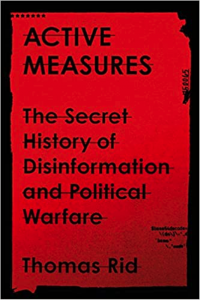 Active Measures: The Secret History of Disinformation and Political Warfare
Active Measures: The Secret History of Disinformation and Political Warfare
By Thomas Rid
Review by Michael Schoenfeld
“The goal of disinformation is to engineer division by putting emotion over analysis, division over unity, conflict over consensus, the particular over the universal,” notes Thomas Rid in his richly detailed and eminently readable “Active Measures: The Secret History of Disinformation and Political Warfare.”
While that description could have been ripped from any of the infinite number of op-eds and cable news panels on the U.S. elections and the corrosive impact of malignant state actors manipulating public opinion on social media, it is also the animating concept of a century’s worth of operations that sometimes seemed as if they were ripped from Mad Magazine’s classic “Spy vs. Spy” cartoon, but were in fact deadly serious.
A professor of information security at Johns Hopkins University, Rid brings his personal experiences as a German-born political scientist and a longtime student of disinformation. In addition to the limited material available from Russian and East German records, declassified files from the U.S. and personal interviews, Rid appears to have hit the archival jackpot with Bulgarian state security, which was one of the KGB’s most loyal and aggressive acolytes.
Rid deftly recounts the four waves of disinformation that can be traced back to the formation of the Soviet Union in the early part of the 20th century, starting with the opening of the truly mass media, which included rapid and inexpensive distribution of printed material, the telephone and telegraph, and then radio.
The post-war era, and the start of the Cold War, saw that tactics and techniques that had been honed to near perfection by all sides of the global conflict turned into an equally serious conflict between the American “political warfare” and the Soviet “disinformation.” This led directly to the third wave in the late 1970’s when the clash of ideologies was positioned as a struggle, literally, for the survival of civilization and the human race. And then, of course, technology disrupted politics, and politics disrupted technology, as the internet democratized disinformation and created the most pernicious of level playing fields.
During this time, the Soviets and the Americans tested their messages on every part of the disinformation spectrum. But certain patterns emerged, like sports teams that usually returned to a favorite style of play
From the founding of the Soviet Union in 1917, Russian spymasters relied on sometimes sophisticated, sometimes crude information warfare to both advance foreign policy goals and root out dissent and treachery, starting with The Trust, an elaborate, convoluted and ultimately successful ruse designed to undermine exiled monarchists who posed a threat to the young Soviet state. The specifics varied in creative ways but tended to rely heavily on efforts to infuse forgeries and hoaxes into credible places, like government ministries, the news media and even libraries, where incriminating documents were sometimes “discovered” in spectacular ways.
A good example, recounted in the book, is the little-remembered but nearly explosive “Tanaka Memorial” that was presented as the “Japanese Mein Kampf” and attempted to upset the balance of power between China, Japan and Russia in 1920’s Manchuria.
At the same time, as Rid notes, the CIA “had discovered that disinformation worked best when factual content was carried by phony outlets – when the source was fake but the content accurate.” This manifested itself in now well-known ways, like the positioning of Radio Free Europe and Radio Liberty as “surrogate” news stations bootstrapped by refugees and funded by concerned citizens when in fact they were CIA assets, as well as the more secretive channels, such as the long-running LC-CASSOCK operation in the 1950’s. Headed by an ex-Wehrmacht U-boat commander, LC-Cassock, Inc. grew into a 35-person PR and publishing house that sought to infiltrate East Germany with women’s magazines, celebrity gossip, dating services and astrology guides, along with perks – like bonuses, private offices, and lavish expense accounts – that ended up being its undoing.
But Rid’s account of the furious gamesmanship that took place in the decade before the collapse of the Soviet Union is perhaps the most interesting part of the book, if only because in hindsight one can see the green shoots of our current crisis of trust. Memories of the great intelligence leaks of the late 1970’s, the mobilization and manipulation of global public opinion on nuclear weapons, and the surprisingly effective campaign alleging that the CIA created AIDS may have gone into hibernation when the Cold War ended, but one can clearly see the roots of what now passes for populism, including the disdain of experts and hostility towards science, in their long tail (Indeed, another one of that era’s greatest hits, the legend that children from Central America and Africa were being kidnapped and butchered so their organs could be transplanted to wealth Americans, is likely one of the progenitors of the QAnon cult.)
“Active Measures” will be most noted for its informed analysis and tightly written depiction of the “hacker” era of disinformation in which we are living today. Rid’s narrative of how the now-familiar players like Guccifer 2.0, Anonymous, WikiLeaks, and CyberBerkut so easily implanted viruses in our body politic is chilling in its implications, particularly since we are living through this part of the battle in real time, with no idea how the story will end, or when the next one will begin.![]()
Michael Schoenfeld is the vice president for public affairs and government relations and chief communications officer at Duke University. From 1986-1993, he held several key positions at the Voice of America, including news anchor, Congressional and public liaison officer, executive assistant to the VOA Director and head of program development for Worldnet TV. He is a member of the Public Diplomacy Council.
